Food for the Soul: Charles I – The Royal Connoisseur of Art
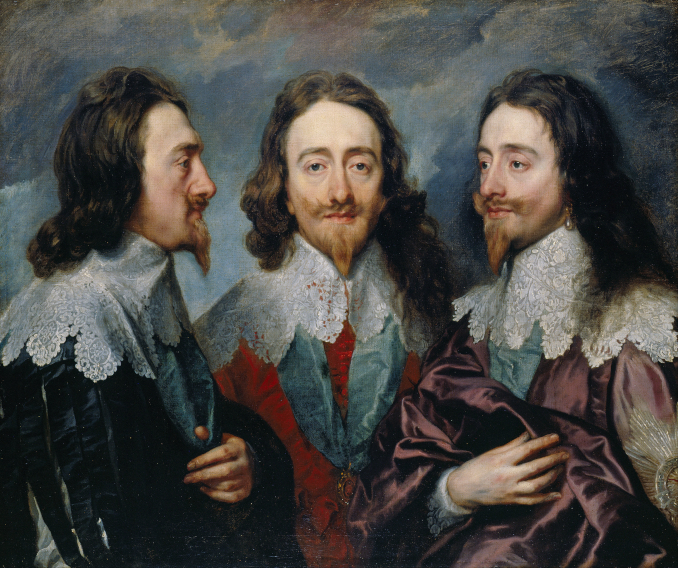
“Ars longa, vita brevis.” ~ Hippocrates, Aphorismi
By Nina Heyn — Your Culture Scout
As the world witnesses a historic change in Great Britain, which welcomes Charles III as the new king (the coronation ceremony has been scheduled for May 6, 2023), it is perhaps worth remembering the first English monarch of this name—Charles I (1600–1649). In history, he is famous as the first modern European king to be executed by his people, but in art history, he is most remembered for his passion for collecting and patronage of such talents as Van Dyck, Rubens, and Inigo Jones, as well as Artemisia and Orazio Gentileschi. In other words, while he may have failed miserably at statecraft, Britain owes Charles I a debt for assembling a priceless collection of art. His collection of 1500 paintings influenced the tastes of generations of British society in general, and its artists and intellectuals in particular. The subsequent dispersal of a large part of his artworks also enriched the collections of connoisseurs all over Europe.
The portrait above, known as Charles I in Three Positions, is a triple portrait of Charles I by the king’s portraitist Anthony van Dyck, who painted about 40 images of his patron in all. This unusual triple view, created as a template for the sculptor Bernini, was sent to Rome as a model for carving a bust. Even in this “utilitarian” likeness, van Dyck ensured a regal and grave look on Charles’s face.

Van Dyck, a pupil of Rubens and a contemporary of Rembrandt, was a prodigy, having achieved the mastery of portraiture at a young age. Thanks to his talent and the natural grace of a courtier, he was welcomed at the court of Charles I. His mastery of portraiture is evident in Charles I with M. St. Antoine, an equestrian picture of the king. Depictions of rulers posed on a horse were a customary theme, executed in important portraits by Velázquez, Titian, and Rubens; van Dyck’s contribution to this template was to show the king outdoors (instead of against a typical dark background or inside a room) and not alone. The king is posed inside a picturesque arch and in the company of a courtier named Pierre Antoine Bourdain, Seigneur de St. Antoine (hence the painting’s title). The man, dressed in scarlet red and striding across the frame, adds to the color contrast and the dynamics of this scene. Putting a short king (Charles I was apparently only 5 feet 4 inches tall) in Titian-inspired steel armor and confidently seated on a magnificent steed in motion was also a way to create an image of power, strength, and control. However, there is a disquieting expression of sadness on the king’s face, as if he was aware that this image was more propaganda than reality. In real life, he was no soldier galloping toward his troops. He loved power and wealth—especially if those enabled him to collect art—but he was not a battlefield commander. This magnificent portrait remained with the king only as long his life lasted. When the collection was broken up after his death, this canvas was sold to Pope Innocent X for £150 pounds. The portrait did return to the royal collection in 1660 when Charles II repurchased it.
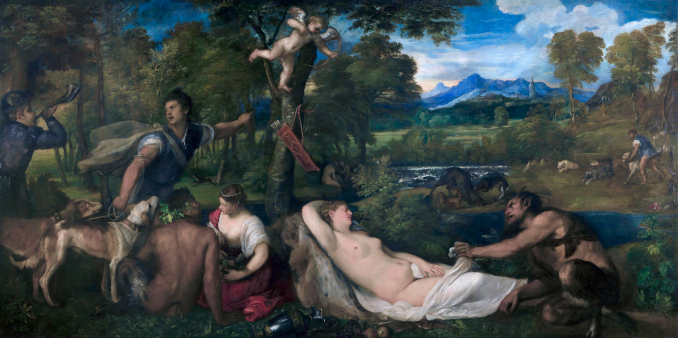
If Charles I inherited his taste and knowledge of art from his mother Queen Anne, he made it his own during his Spanish adventure. In 1623, he made a romantic, mad-cap dash to Spain with his mentor (and Foreign Minister) the 1st Duke of Buckingham (romantically but inaccurately immortalized in literature by Dumas in his The Three Musketeers). The two men traveled incognito as “Jack and Tom Smith,“ planning to speed up negotiations for the hand of the Spanish princess Infanta Maria. The negotiations ultimately petered out (and later on, England entered into a war with Spain), but while Charles I was at the Spanish court, he had the opportunity to see the masterpieces in the royal collection in Alcazar. As a marriage candidate, Charles received from King Philip IV a gift of two canvases by Titian—the Pardo Venus (now at the Louvre and also known as Jupiter and Antiope ) and Portrait of Charles V with the Hound (now at the Prado). On his own, Charles I also bought another Titian work: A Girl in a Fur Coat (now at the Kunsthistorische Museum in Vienna).
TITIAN’S EMPERORS
Probably the king’s most magnificent acquisition of Titian works was in the form of a set of portraits of Roman emperors. This is one part of Charles’s collection that is as famous as it is non-existent.
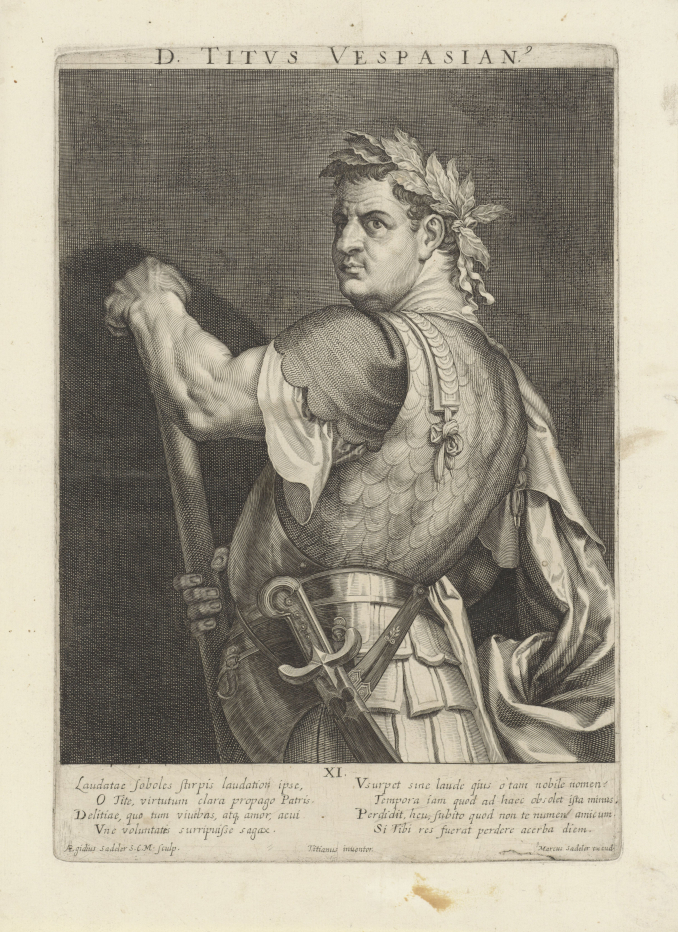
When in 1536 Federico Gonzaga of Mantua commissioned from Titian a set of portraits of Roman emperors, it was a most obvious choice of both artist and subject. Titian had, for years, been Frederico’s favorite artist, if not almost a friend despite their vastly different social status. Titian would provide quick portraits that Federico used as diplomatic gifts, along with more elaborate portraits of the family, numerous other artworks, small gifts (including a lynx kitten once), and services. He would have been an obvious choice for Federico’s plan to create a roomful of canvases depicting Roman emperors, augmented by sculptures and artifacts from the period. The theme of the 12 most famous Roman rulers was a popular one for centuries before and certainly after, all the way to the 19th century. The idea and the number 12 came from the popular classic text by Roman historian Suetonius (c. 69–122 AD), a book well known to educated people in the Renaissance. While “collecting the 12 Caesars” usually would just mean collecting ancient coin sets with the heads of the emperors, mighty patrons in Italy, France, or Spain also would order paintings, engravings, or sculptures directly from artists, or at least buy copies of famous artworks with this popular subject. When he was arranging his themed room called the Camerino dei Cesari, Federico was in a better position than most patrons—he could order a set of large paintings directly from one of the most sought-after artists in Europe.
Titian painted the set of 11 paintings between 1536–1539. It is not clear why he did not create a full set, but in any case, the 12th “missing” image of emperor Domitius was later completed by Giulio Romano. Titian delivered and installed the set in the Mantua palace by the end of 1539, but unfortunately, his longtime patron Federico died a few months later. The Caesars Room survived for another 90 years, until Federico’s impoverished descendants sold its contents through an intermediary to Charles I. The paintings were terribly damaged in transport when some mercury spilled over the canvases, damaging a few portraits beyond salvage. One of them, the portrait of Emperor Vitellius, was recreated by van Dyck. Whether damaged, copied, or restored, the set did not spend a long time in England; after Charles’s fall, the paintings were given to creditors and eventually resold to King Philip IV of Spain for £600.
In 1734, the fire of the Royal Alcazar in Madrid destroyed the entire set—Titian originals, copies, and van Dyck replacement. All we have now is a set of prints created by an engraver named Aegidius Stadeler (the set itself becoming famous and much copied for centuries), numerous contemporary copies by Italian painters, and many later paintings that would make reference to either postures, costumes, or the style that Titian created in his originals. But the famous Titian Caesars themselves are no more.
MANTEGNA’ S TRIUMPH
Titian’s set of Caesars may not have been fated to survive to our times, but there is a different set of artworks on Roman history that has remained a part of the British royal collection until the present day.
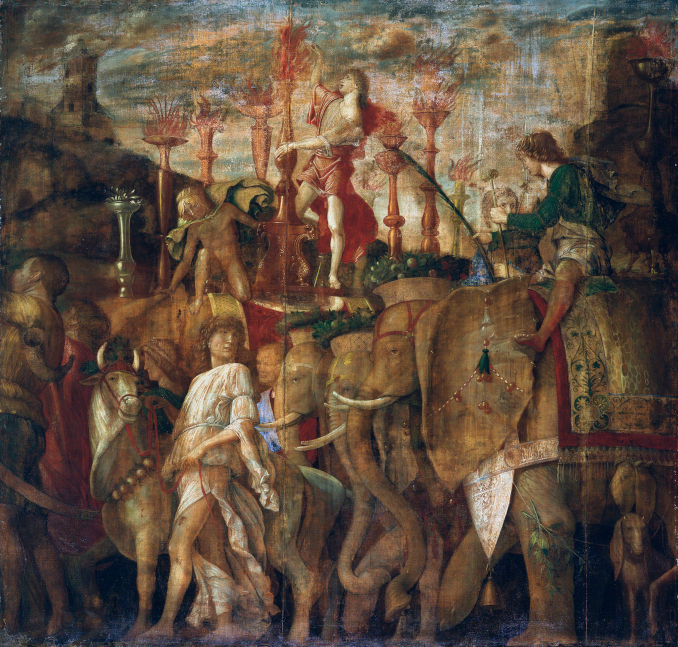
At the turn of 16th century, the Gonzaga court of Mantua was one of the cradles of Renaissance art. Thanks to the dukes’ patronage, their San Giorgio castle filled with Andrea Mantegna’s frescoes and later gained paintings from artists such as Titian, Tintoretto, and Andrea del Sarto. A century later, however, the Gonzaga family’s fortunes were in decline. Besieged with financial woes, they parted with their Titian Caesars and major works by Raphael, Carracci, Caravaggio, and Rubens, but they still held on to their greatest treasure by Andrea Mantegna—nine canvases called Triumph of Caesar. Similar to the contemporary Gozzoli frescoes in Florence, Mantegna’s canvases are a panorama of scenes arranged as if they were a moving picture. The viewer is invited to be a spectator at a triumphal parade of Julius Caesar after his Gallic Wars’ victories. Other than the exotic elephants above, the pictures feature musicians and bearers of trophies, crowds, chariots, and captives until the last image of Julius Caesar seated on a throne. By 1628, though, the Gonzaga family could not hold out any longer, and they negotiated the sale to Charles I of Mantegna’s Triumph for the sum of £10,000. Charles’s enormous spending meant that the treasury was constantly short of money for his art hunting, so his bill was not paid until four years later.
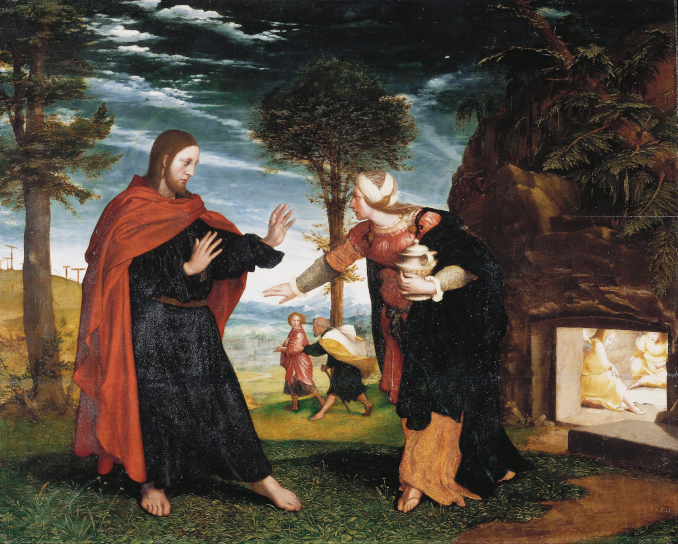
Charles shared a passion for collecting art with his wife. Henrietta Maria was a French princess, mistrusted by her English subjects for being both foreign and Catholic, but her marriage arranged for strategic reasons turned out to be a good one. Married at age 15, she bore Charles eight children, two of whom became kings. She brought to the court French luxury, fashion, and cultural appreciation, and she supported her husband in his collecting passion. She collected old Italian masters, and at some point she acquired Holbein’s Noli Me Tangere. The picture wandered a lot, because at the start of the Civil War, Henrietta Maria escaped to France with the children; she then returned when her son Charles II ascended to the throne in 1660. Barely five years later, the queen escaped England again to avoid the plague. After her passing, the Holbein picture entered the British royal collection permanently.
While the theme of Jesus refraining from the touch of a mortal woman is a common one in paintings, Hans Holbein’s version is compositionally beautiful, painted with energetic slashes of contrasting colors and with the wonderful detail of angels crouching in the empty but luminous tomb. The colors of the robes of Jesus and Marie Magdalene are reversed, with both of them bending toward each other as if in gracious dance or at least engaged in a dialogue about their respective roles. The colors and movements are repeated in the figures of St. John and St. Peter seen in the distance.
RUBENS’S CEILING

Charles’s passion for collecting was so strong that he continued to acquire works while in his Oxford exile during the Civil War. Alas, being an art connoisseur is not a protection against the winds of history. Charles was unpopular due to his aloofness and his absolutist views. As the son and husband of Catholic rulers, he also was suspected of Catholic leanings in a country that by then firmly supported Protestantism. Faced with the relentless political and military drive of Oliver Cromwell, the monarch was arrested and condemned to death in 1649. Ironically, when Charles I walked toward the site of his execution, he traversed the Banqueting House. The ceiling in this hall was decorated by Paul Rubens, who Charles I had commissioned in 1629 to paint panels that glorified the Stuart dynasty. The artwork is unique for being the only ceiling work by Rubens that still survives in place. The title of the Rubens ceiling is the Divine Right of Kings, an even more bitter irony for the king condemned by his opponents to a scaffold, erected right outside the Banqueting House, on a chill January morning in 1649.
DISPERSAL
Barely a few months after the execution, the Parliament passed an “Act for the Sale of King’s Goods.” Mantegna’s Triumph was spared, but the majority of the 1500 artworks in Charles’s collection were inventoried and sold everywhere—some to grace the houses of local burghers, and some scooped up by Spanish and French ambassadors for their kings. For many of the artworks, the odyssey of changing hands was just beginning.
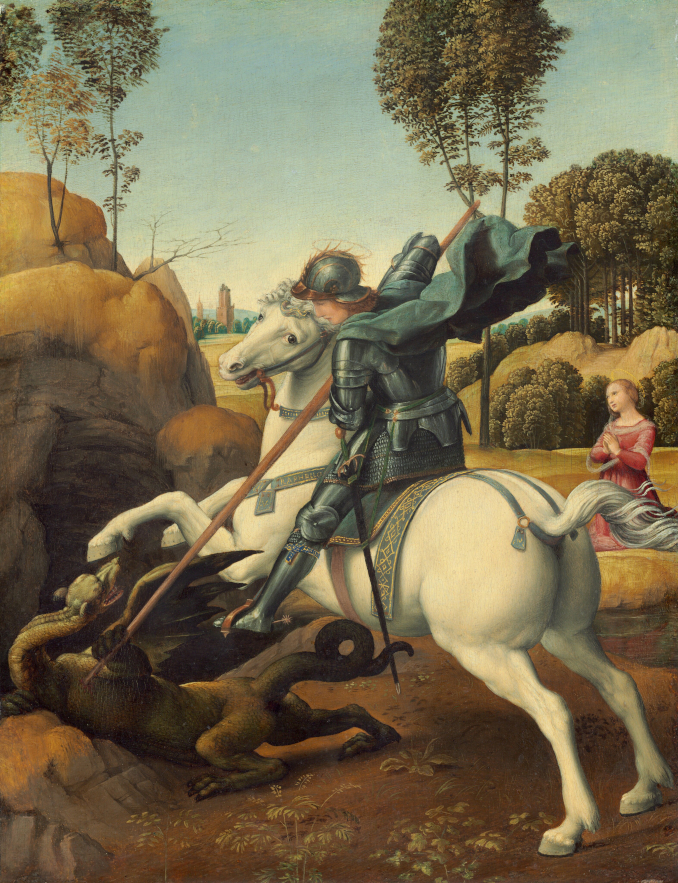
Raphael’s small and charming panel St. George and the Dragon arrived in England in the early 17th century. Charles I received it as a gift from the Earl of Pembroke, and when the collection was dispersed after Charles’s death, the Raphael ended up in the hands of an avid French collector, the banker Pierre Crozat. His collection was later purchased by Catherine the Great, and the Raphael would have remained in St. Petersburg if not for the fact that by 1931, the Soviet economy was in dire straits (communist economies having a general tendency to go broke). The Soviets sold the Raphael to capitalists in the form of Andrew Mellon, who acquired the painting and then in turn donated it in 1932 to the National Gallery of Art in Washington. Charles’s little jewel of Renaissance art has traveled the globe.
Like Charles I, the new King Charles III is also into art. For years, he has been painting very accomplished watercolors, which are exhibited globally and marketed to support his charities. For example, it was reported in 2016 that sales of his artwork and reproductions had brought £6 million to charities that he sponsors. And unlike Charles I, the new king should be able to preserve the British royal collection of art for his nation.
